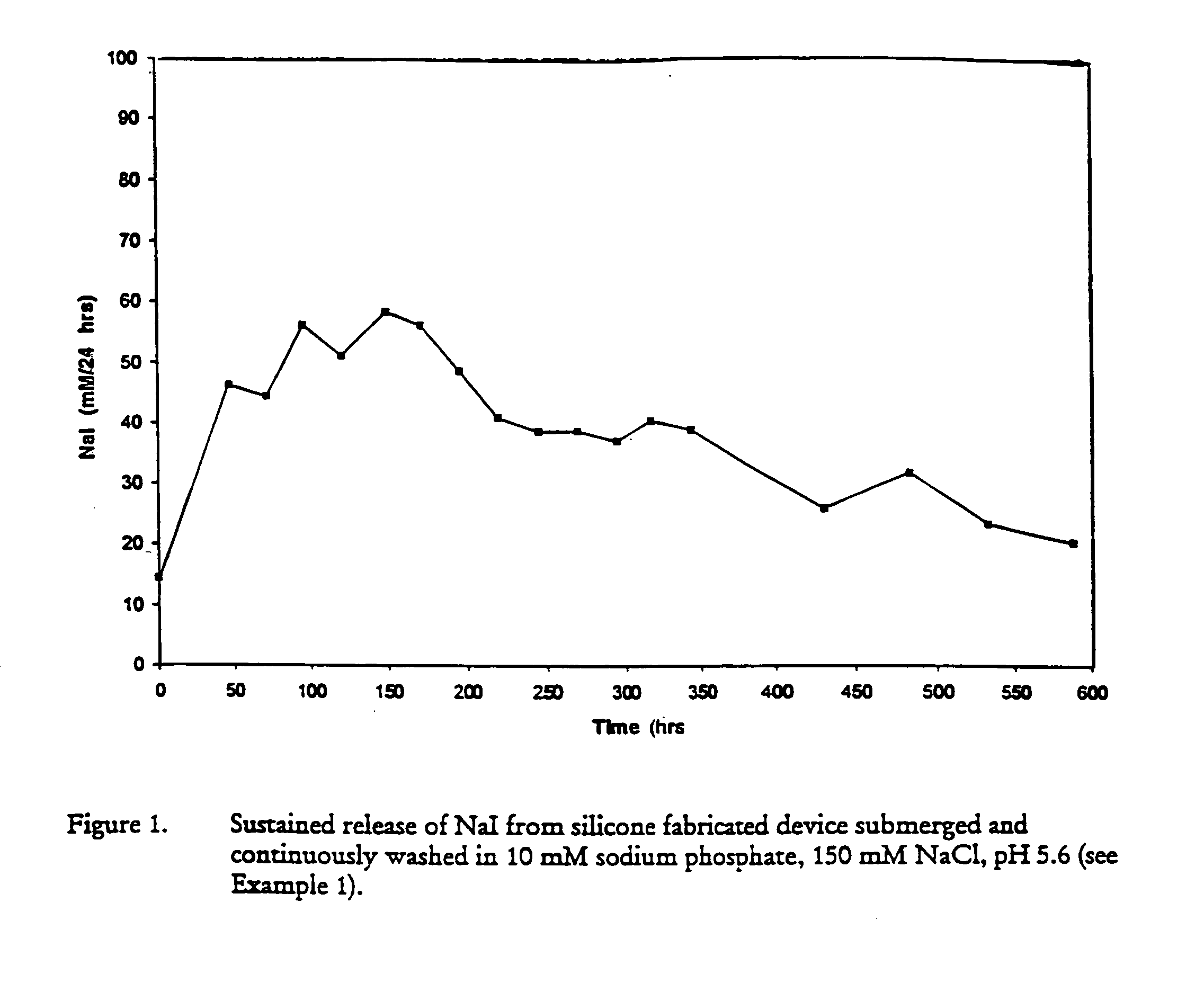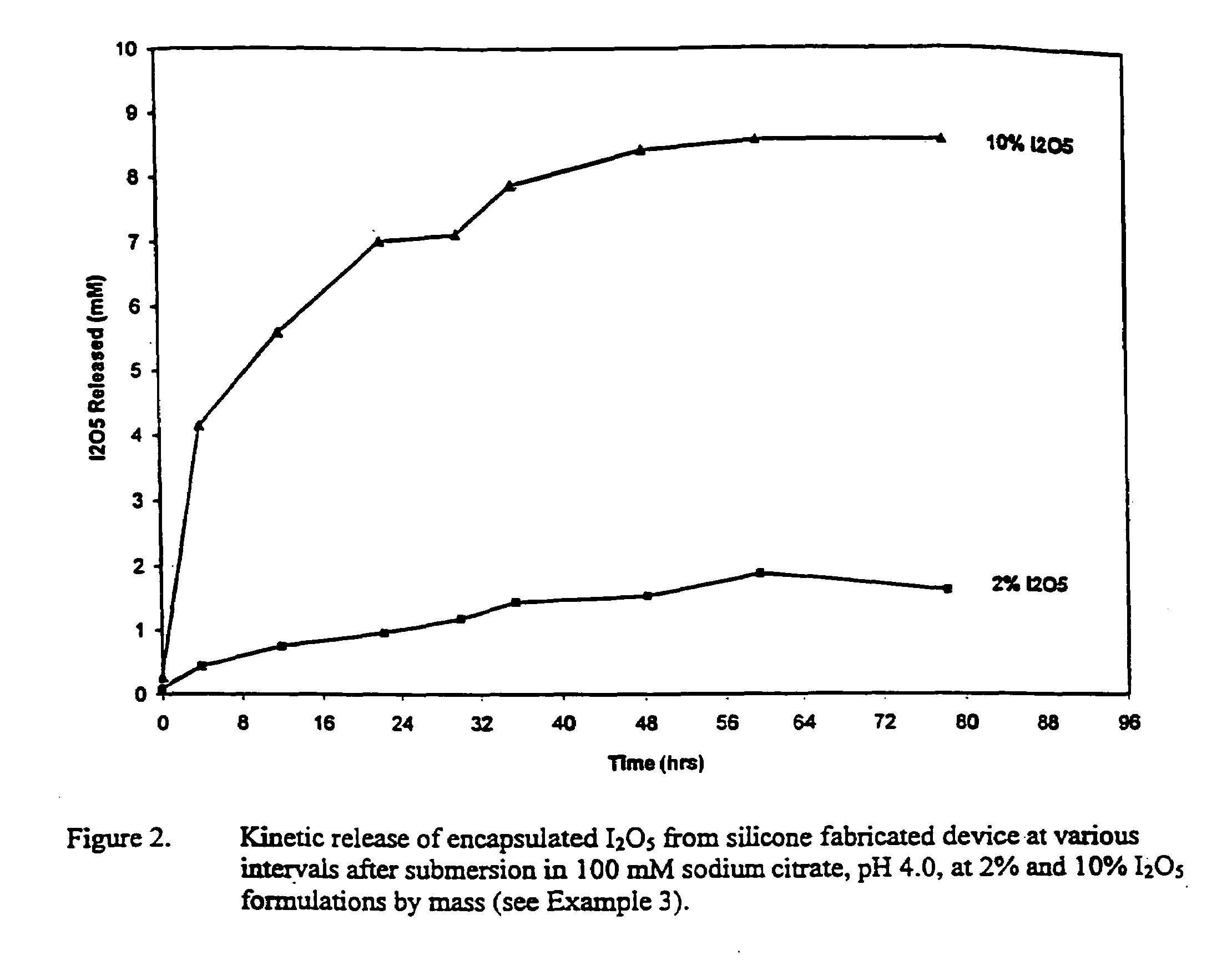Medical device having anti-infective and contraceptive properties
- Summary
- Abstract
- Description
- Claims
- Application Information
AI Technical Summary
Benefits of technology
Problems solved by technology
Method used
Image
Examples
example 1
[0131]This example illustrates the incorporation of iodide into a silicone disc device and long term release rates of iodide upon submersion and washing of the device in buffer. Finely ground sodium iodide (3 g), prepared in a mortar and pestle, was mixed into 10 g of RTV silicone elastomer (polydimethylsiloxane) to which was also added 1 g dibutyl tin dilaurate catalyst stock solution. The ground crystalline sodium iodide powder recovered from the mortar and pestle was added last to the polymer base after thorough mixing of the catalyst into the silicone, and the silicone then poured into 5.0 cm diameter Petri dishes to a depth of 0.3 cm in thickness. After 24 hrs, the cured disc was removed, thoroughly rinsed in 10 mM sodium phosphate buffer, pH 5.6, made up in 150 mM NaCl, and then placed into a 150 ml beaker containing 10 ml of the same buffer. At varying intervals (see FIG. 1), including an initial t=0 measurement, buffer was drained from the beaker and device, and set aside fo...
example 2
[0133]This example illustrates the release of glucose oxidase and horseradish peroxidase encapsulated within a device fabricated from a silicon elastomer. Specifically, the device was fabricated with a glucose oxidase / horseradish peroxidase and iodide formulation into a disc with silicone elastomer. The subsequent release of the formulation from the device was measured after immersion and continuous bathing in buffer. RTV Silicone elastomer (10 g, polydimethyl siloxane with silanol end caps) was mixed with silicic ester dibutyl tin dilaurate catalyst (1.1 g), and into this uniform mixture 50 mg crystalline glucose oxidase (D-glucose:oxygen 1-oxidoreductase; EC 1.1.3.4), 5 mg crystalline horseradish peroxidase (donor:hydrogen-peroxide oxidoreductase; EC 1.11.1.7) and 3 g of finely ground sodium iodide were slurried. The slurry was poured into 5.0 cm diameter Petri dish to a thickness of ˜0.1 cm, cured for approximately 24 hours at room temperature, removed from the mold, briefly rins...
example 3
[0139]This example illustrates iodate reduction and conversion to elemental iodine and microbicidal tests on fabricated devices encapsulated with iodate and iodide in silicone-based polymer. Based upon evidence that many body fluids are rich in reducing compounds, antioxidants, and the like, alternate methods of generating elemental iodine de novo from iodide and iodate were investigated using Brain Heart Infusion (BHI) media to mimic complex body fluid conditions. BHI is a rich source of reducing compounds of the type found in body fluids. The formation of elemental iodine de novo from iodide and iodate in BHI media was confirmed by titrating solutions of BHI with incremental additions of iodide and iodine pentoxide (the anhydride of iodate), either in combination, or with iodine pentoxide alone. Following additions of trace amounts of iodide in combination with iodine pentoxide (total iodine3− formation (e.g., formation of elemental iodine and its complexation with iodide ion). Th...
PUM
| Property | Measurement | Unit |
|---|---|---|
| Fraction | aaaaa | aaaaa |
| Fraction | aaaaa | aaaaa |
| Fraction | aaaaa | aaaaa |
Abstract
Description
Claims
Application Information
 Login to View More
Login to View More - R&D
- Intellectual Property
- Life Sciences
- Materials
- Tech Scout
- Unparalleled Data Quality
- Higher Quality Content
- 60% Fewer Hallucinations
Browse by: Latest US Patents, China's latest patents, Technical Efficacy Thesaurus, Application Domain, Technology Topic, Popular Technical Reports.
© 2025 PatSnap. All rights reserved.Legal|Privacy policy|Modern Slavery Act Transparency Statement|Sitemap|About US| Contact US: help@patsnap.com



